Similar Posts
(Written by Nikos Pantanizopoulos and Lynne Attaway)

Church of the New Martyrs and Confessors, Butovo, Moscow, Russia.
Beauty in an Orthodox temple is something easily taken for granted, but it has deep spiritual and theological significance. It can also be realized even by those who do not have the skills of iconography. Beauty is an integral feature of Orthodox temple. We honor God when we show that we have beautified our place of worship. For Orthodox Christians, creating beauty is a very high calling, because by creating beauty we share in God’s activity that reflects his nature. [1] We beautify that which is precious to us.
Decorative borders are an overlooked and undervalued element in new churches. These borders are an important tradition of the Orthodox life. We see the borders in traditionally furnished churches, both new and old.
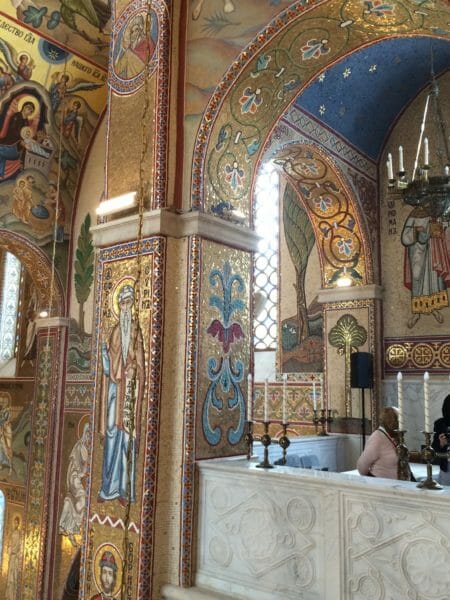
Church of the Protection of the Theotokos, Yasenevo, Moscow, Russia. Photos by Lynne Attaway unless otherwise noted.
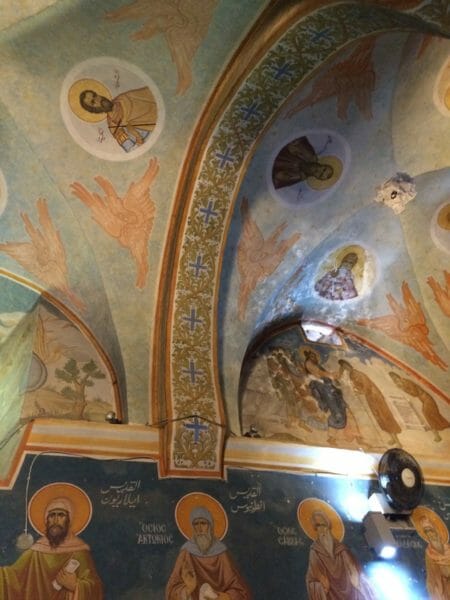
Church of the Annunciation, Nazareth, Israel.
The parishioners of St. Anne Orthodox Church, Oak Ridge, Tennessee, have used $200 of paint, $200 of Frog Tape®, and $20 of stencil material to add decorative borders to their worship space.
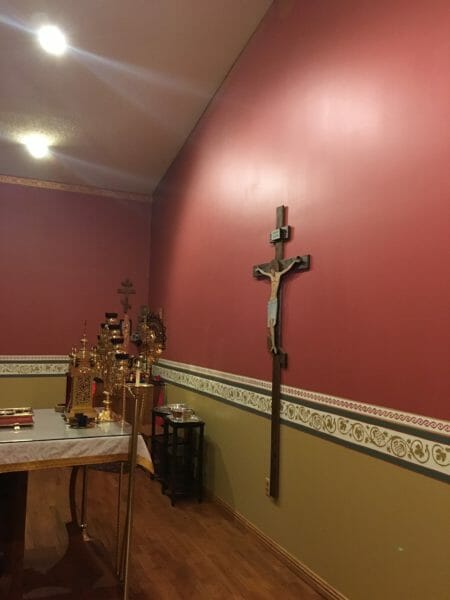
The altar area with two-pattern border and contrasting lower wall color.
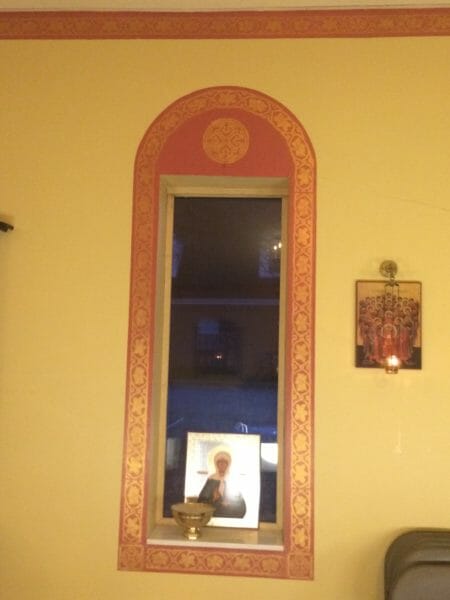
Classical round-arch frame around a contemporary window and upper wall border.
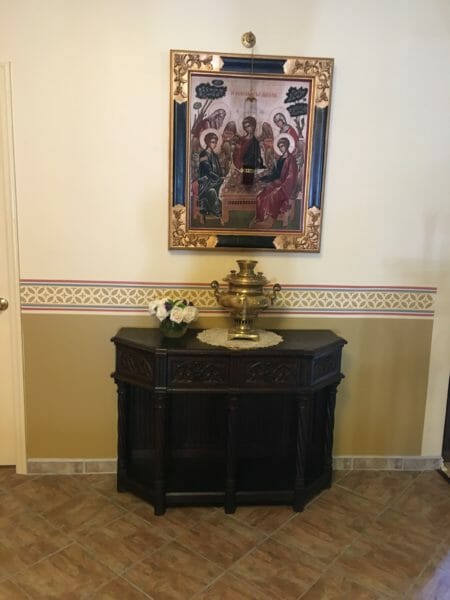
The narthex with Byzantine border and contrasting lower wall color.
Proper Characteristics of Orthodox Church Architecture
These decorative borders help to complete the proper characteristics of Orthodox Church architecture, as identified by Andrew Gould. All of the elements of architecture and furnishings contribute to making the church itself the Icon of Heaven, the City of God, with its jeweled foundation, its gates of pearl, and its golden streets.
The proper characteristics will express: solidity, radiance, mystery, introversion, energy, stillness, universality, exotic, local, authenticity, elegance, and authority. [2] Here is a photograph of Varlaam Monastery in Meteora, Greece, showing a fully outfitted Medieval church.
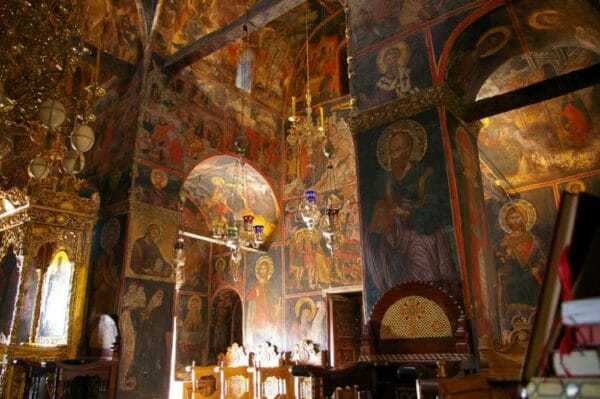
Kirkby, A, Photo of Varlaam Monastery, Meteora, Greece, in Gould, A., “An Icon of the Kingdom of God, part 5,” in Orthodox Arts Journal, October, 2012.
The Beautification Project at St. Anne Orthodox Church
The Medallion, the Windows, and the Upper Border
The project at St. Anne Orthodox Church started when Niko Pantanizopoulos saw the new iconostasis, created by Dmitri Shkolnik Studios, and had the vision to use some of the decorative designs and bring them out from the altar and embrace the rest of the church. He wanted to create a more inviting worship experience. Niko has spent a lot of time in Greece, visiting family, so he has more experience in viewing Orthodox churches and monasteries than most converts have had.
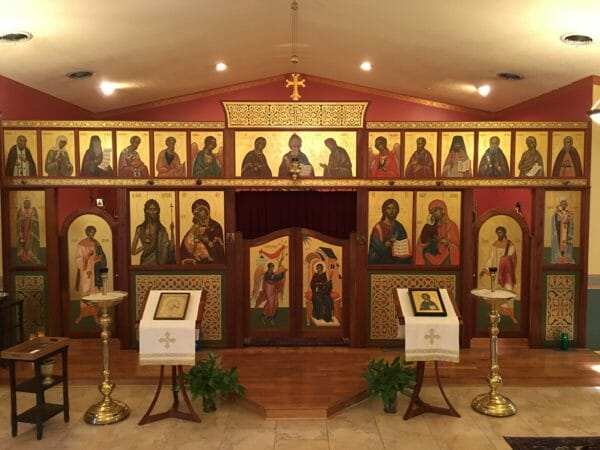
Iconostasis, the inspiration for the designs.
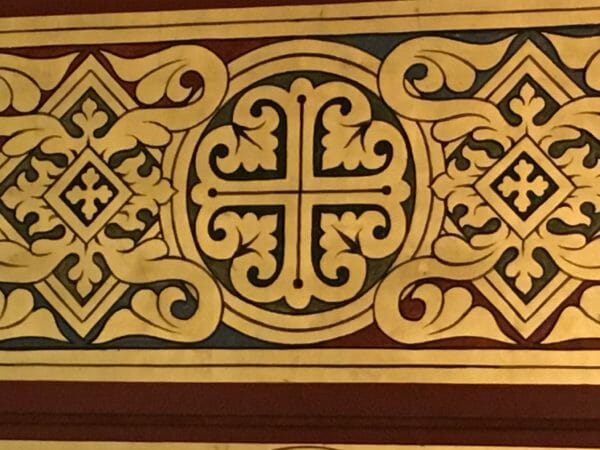
The central medallion above the Royal Doors.
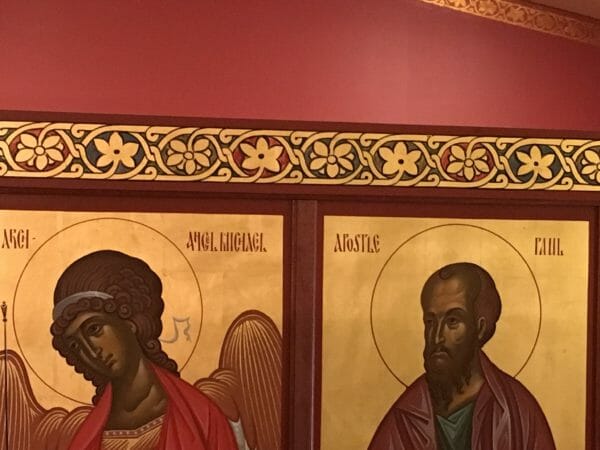
The floral border at the top of the iconostasis.
Niko used his knowledge of design from his background in landscape design combined with knowledge of Orthodox church aesthetics. He used the medallion in the iconostasis decoration to create a focal point above the altar. He used the floral border in the iconostasis to surround the windows and to create round arches to emphasize the windows and to express classical Roman shape. He repeated the medallion within the arches of the windows. He painted and decorated a border at the wall-ceiling junction to soften the transition, to unify the space, and to bring the design into the whole church.
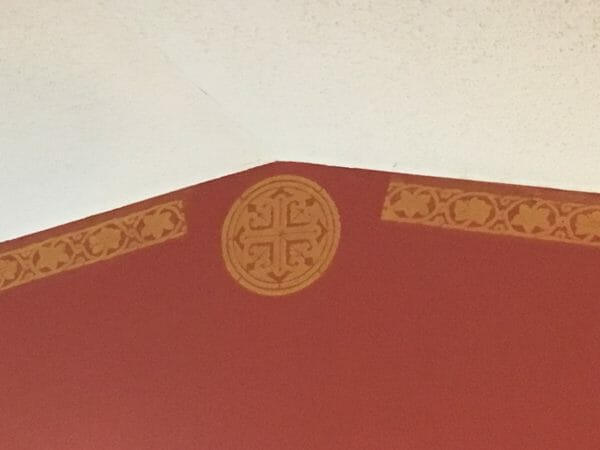
The focal point above the altar, based on the central medallion.
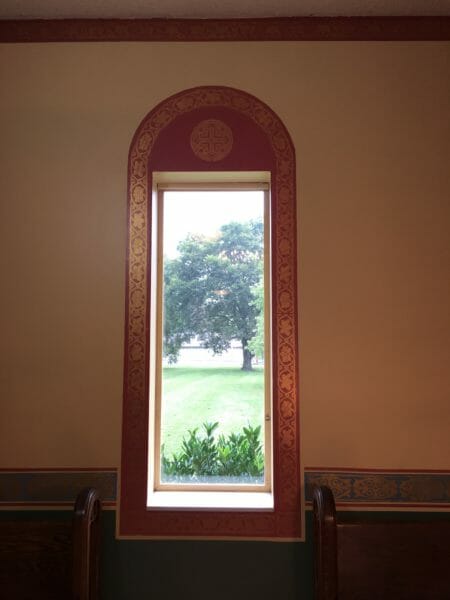
The windows with round arch frames and radiant borders.
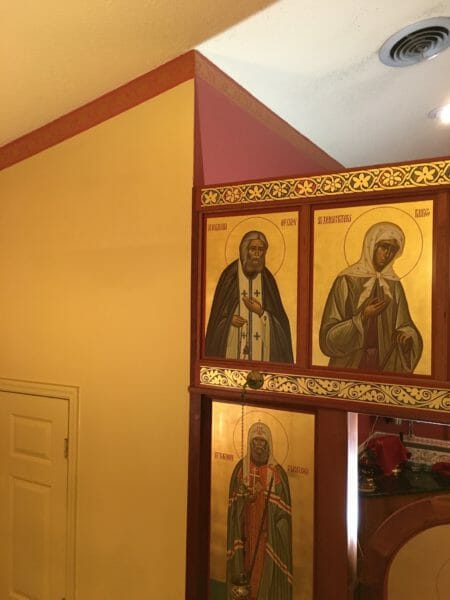
The floral pattern creates a wall-ceiling border, unifying the space.
Niko has the skills to gild with true gold leaf from prior church decorating experiences, but the technique was cost prohibitive. He also has experience with gilding with mica powder. Since this was an indoor project, he used water-based gold size. The designs created with mica powder give a soft glow to the church, letting the church shine with an inner radiance.
The Lower Nave Walls
A few years later, Father Stephen Freeman, Mother Beth Freeman, and Lynne Attaway participated in pilgrimages in the Holy Land and in Russia. We loved the decorations we saw in the churches, and we remembered Niko’s work. We realized that we could add more decorations to our church.
The second project continued the decoration in the nave. First, we painted the lower portion of the walls a dark green, using one of the colors in the iconostasis decoration. This dark lower portion creates a feeling of solidity, of being in a fortress. It is like being on a ship with good strong side rails that give a feeling of safety. The word “nave” comes from the Latin word for “ship.”
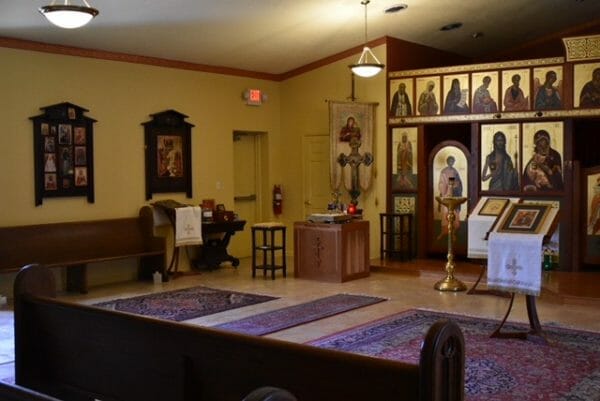
The nave with pale gold walls from floor to ceiling.
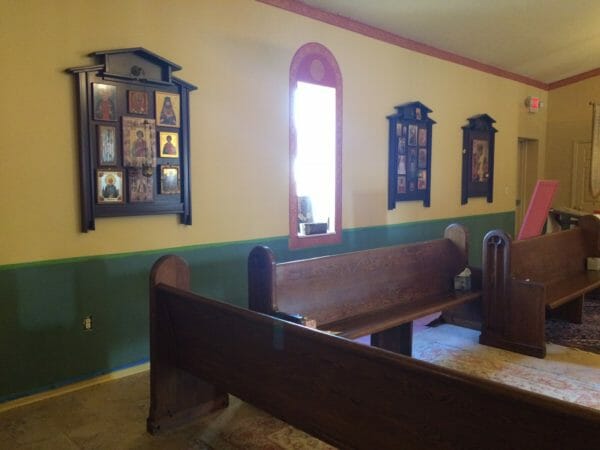
The nave with the lower portion painted green. (Painter’s tape still in place.)
We added a decorative border above the green base, in order to soften the transition between the two colors. We chose a pattern from the decoration of the Church of the Holy Savior of Chora, in Istanbul, Turkey. Bands of color, often red or blue, usually frame the border patterns. For this project, we painted the gold design over a blue base, and painted colored stripes above and below the wide blue band. Then we applied the mica gilding powder over the gold design. The gilding added depth and radiance to the design.
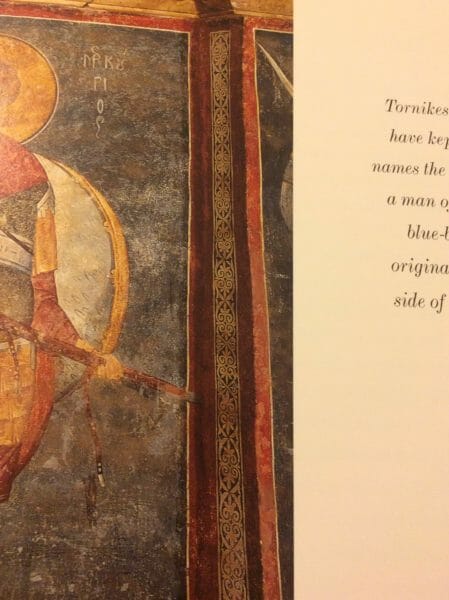
Ertug, A., A border in the Church of the Holy Savior in Chora, Istanbul, Turkey, in Ertug and Mango, The Scroll of Heaven, 2000.
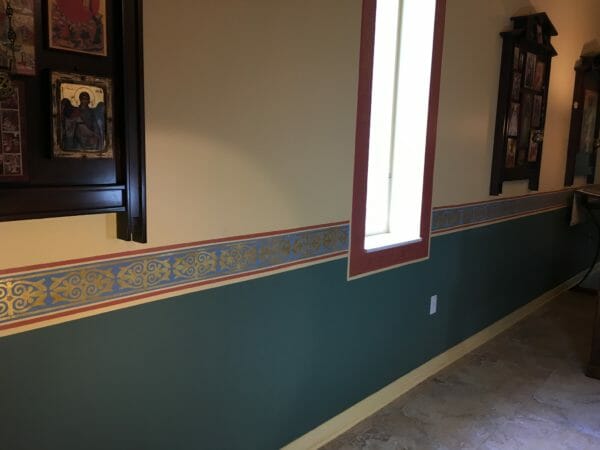
The nave with the new border between the upper and lower wall colors.
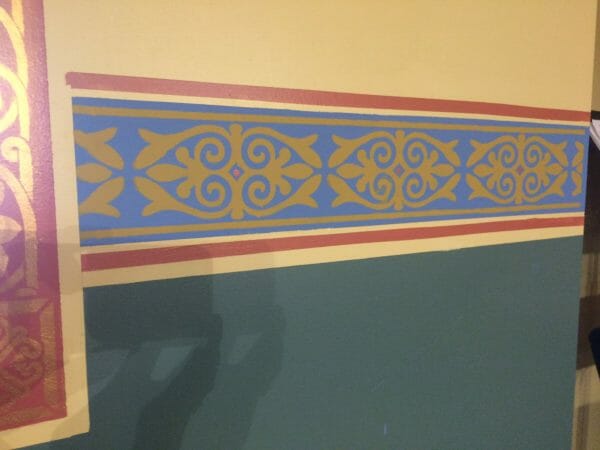
Detail of the nave border with gold paint on a blue base, and stripes above and below.
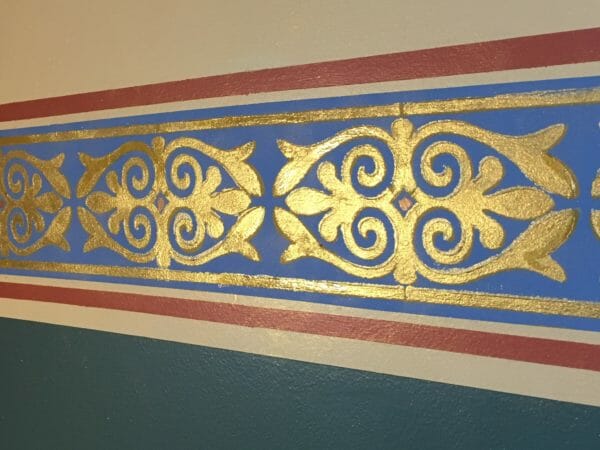
The nave border after application of gold mica powder.
The Narthex
The third project was in the narthex. We again used a darker color for the base, and we used a traditional Byzantine design for the border. We repeated the red and blue stripes to relate to the colors in the nave decoration. We did not add gilding in the narthex. We wanted to show a hierarchy of space. The nave is more important than the narthex.
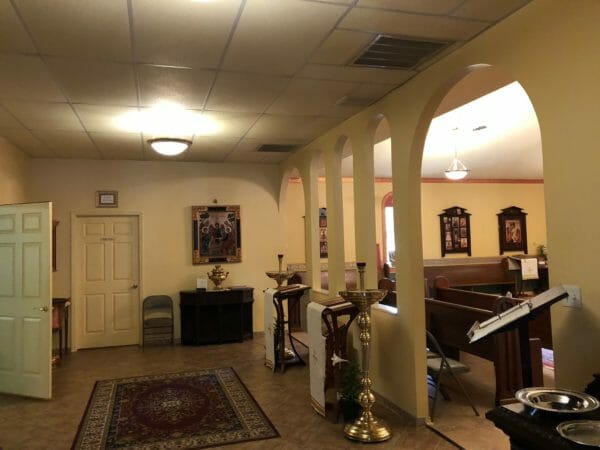
The narthex before decoration.
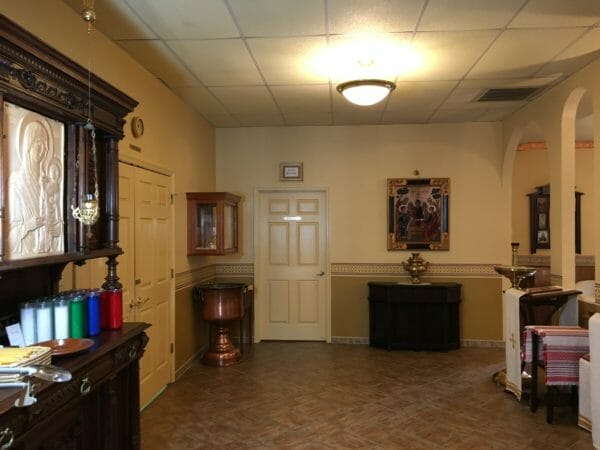
The narthex after the border decoration and contrasting lower wall color. Icon of St. Anne carved by Jonathan Pageau.
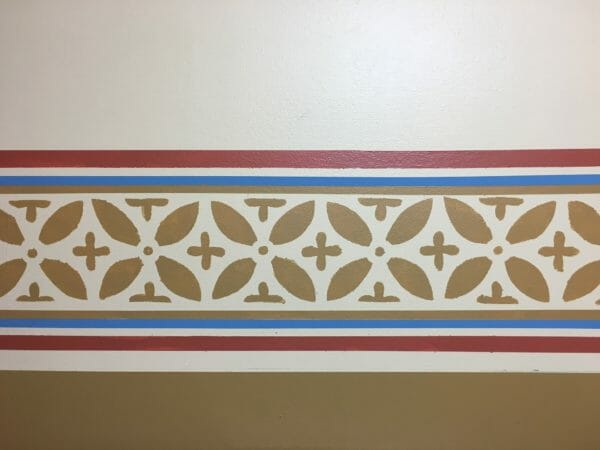
Detail of the Narthex border.
The Altar
The fourth project was in the altar. The walls had been painted a deep red, at the suggestion of the iconographer, to use a color from the frames of the icons on the iconostasis.
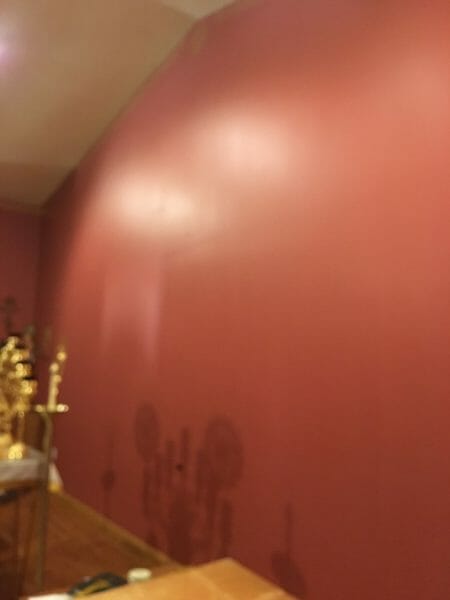
The altar area before decoration.
We painted the lower area gold, to lighten to the space, and created a border that was wider and more ornate than the other borders. We used a grapevine pattern, a motif that Niko says is often used in Greece in the altars, referring to the Eucharist and to Christ’s statement in John 15:5 “I am the vine; you are the branches.” The pattern we used was adapted from the Church of San Vitale, in Ravenna, Italy.
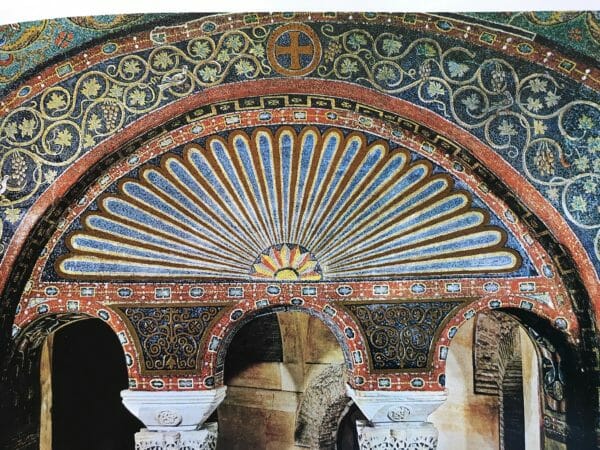
Bustacchini, G, photo of mosaic grapevine design in San Vitale, Ravenna, Italy, in Ravenna, Mosaics, Monuments and Environment, n.d.
Then we added an additional border pattern and bands of stripes. We embellished the grapevine patterns with green veins on the leaves and some gilding on the vines.
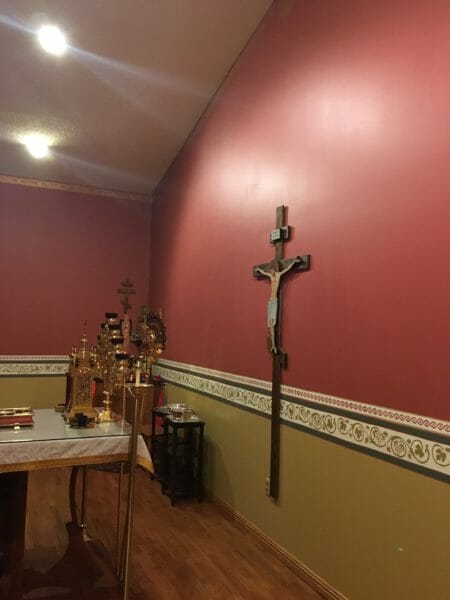
The altar area after the two-patterned border and contrasting lower wall color.
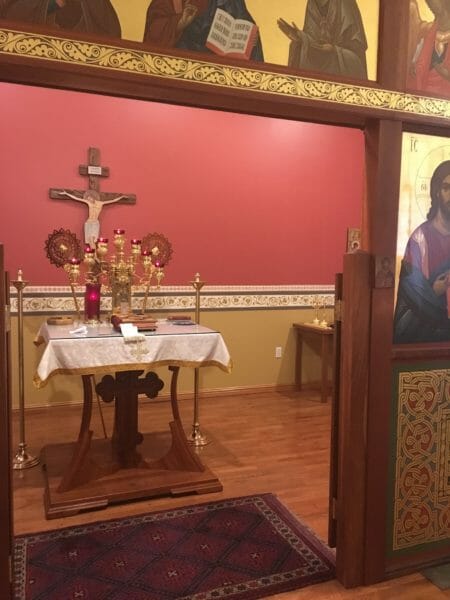
The altar decoration viewed from the nave.

The altar border detail, with gilded highlights and light green veins on the leaves.
The Place of Decoration in Orthodox Church Design
How have these projects added to the proper characteristics of Orthodox church architecture as identified by Andrew Gould?
Contribution to Proper Characteristics of Orthodox Church Architecture
The contrasting lower portion of the walls adds to the feeling of solidity, of protection, and of safety, as in strong side rails around the deck of a ship. The use of gilding powder creates radiance emanating from the walls, a symbol of the uncreated light. The various patterns in different parts of the church add to a sense of mystery, that not everything is revealed at once. The borders and contrasting bands of color add energy, a feeling of being alive and wakeful. They provide a vibrant interplay of patterns and colors. The round arches created with paint and a stenciled border give the church the appearance of the architecture of Rome, which provides the grounding of all Orthodox architecture. The use of materials is respected. The designs are paint. They are not wallpaper. The borders add a sense of elegance to the church. They add adornment, to flatter the beauty of the church, as the bride of Christ is to be adorned. They provide pleasing details to soften the transitions between surfaces. A church rightly adorned expresses spiritual authority.
Beauty is the overarching theme of these principles. We called our projects the beautification project because we understand the importance of beauty in an Orthodox church. As Father Stephen Freeman says, to create beauty is to do priestly work. [3]
The Proper Expression of the Masculine and the Feminine in Church Design
And what do we say when people tell us that decoration is just an extra? A church expresses theology, and Orthodoxy proclaims a proper understanding of the value of both masculine and feminine elements of our relationship to God. We represent the strong qualities of God with the thick walls, with the strong iconostasis, with the letters “ICXC NIKA” (Jesus Christ, Conqueror) on our communion bread. And yet there is another, very important quality of our relationship to God, and that is of the feminine, as the Theotokos said, “Let it be to me according to your word” (Luke 1:38) These feminine qualities of our relationship to God are expressed in the decoration, the details of adornment, in the delicacy of vines, flowers, and scrolls. Even as the communion bread stamp has “ICXC NIKA,” it also has a border and decorative crosses.
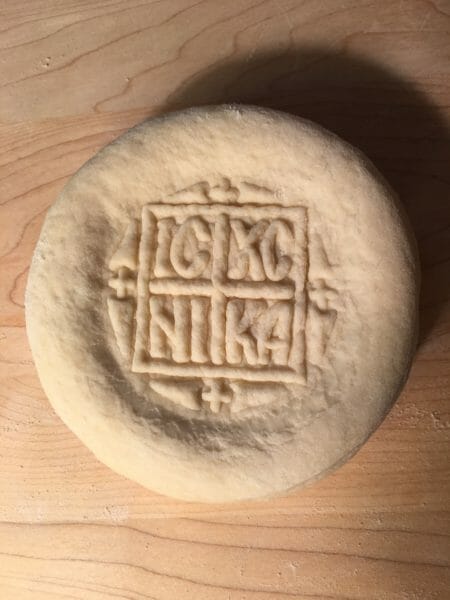
Stamped prosphoron, with ICXC NIKA and a decorative border, showing the masculine and feminine elements of Orthodox worship.
Jonathan Pageau says that the church in the West has been influenced by principles of the Enlightenment, and it has given primacy to masculine characteristics of strength and rational thought. But the Orthodox church, in its arts and worship, has always balanced the masculine—the rational, strong and active, with the feminine–the responsive, soft, decorative. The church has traditionally used both strength and elegance to show our relationship to the Lord. [4]
Creating Decorative Borders
If a parish would like to add decorative borders to their worship space, here are several things to consider.
Unique Qualities of Byzantine Design
Byzantine design has unique qualities. As Kostas E. Tsiropoulos said, “Byzantine art is a fusion of Hellenic-Roman art and Persian art, and of the Imperial life and the ascetic life.” [5] Byzantine decoration is robust and vigorous. It is unlike European decorative style, unlike Persian art, unlike Moorish art, and unlike contemporary style. The Byzantines use decoration in abundance. Modern stencil designs and modern style books do not provide adequate patterns for these designs. To develop a plan for a church, it is good to immerse oneself in the designs of traditional churches. It is essential to visit fully decorated churches and/or view photos of church interiors. Vestments and other church fabrics can be sources of design. Byzantine Decorative Art is a classic collection of patterns. The Orthodox Illustration Project has traditional designs. The online site Pinterest could be a source of patterns and photos of Orthodox church interior decoration.
Methods to Create Designs
Several methods could be used to create these designs. Some lend themselves to brush work, and some to stencils. For those whose brush skills are limited, stencils provide a good way to do the work. We created the patterns for our designs from photos of churches and from Byzantine pattern books, and we cut our own stencils. We used laser cutters and X-acto® knives. We have not found any contemporary, ready-made designs in the United States that would represent the Byzantine style.
The Value of Art Produced by Hand
Everything that we do for the church should be done with the utmost of care. Yet the Byzantines recognize that hand work will have minor variations. They honor those variations. In this age of designs that are produced by machine, we can recognize the value of work done by hands.
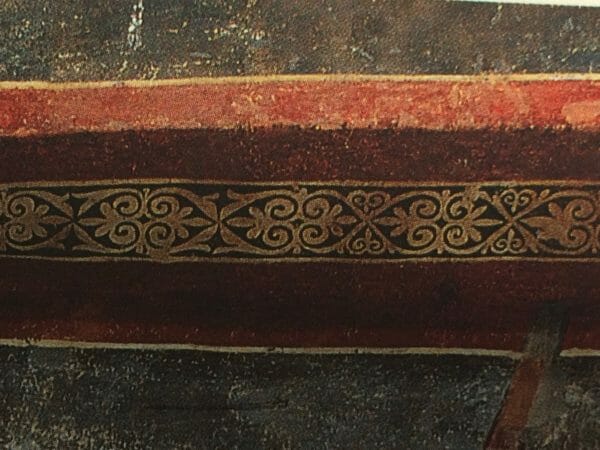
The painted border in the Chora church, showing minor variations, from Ertug and Mango, 2000.
Conclusion
Traditional Orthodox churches have iconography and decoration covering all their surfaces. New churches, and churches in converted spaces, while they are preparing for full decoration, might use this method to create decorative borders to add to the decoration and beautification of their church, and to present an icon of the Kingdom of Heaven. Orthodox decorative arts can add solidity, radiance, mystery, energy, universality, elegance, and authority to worship spaces.
The Joy of Creating Beauty
And for those who do the work of decoration? We feel like Petros Vaboulis, author of Byzantine Decorative Art and student of Fotis Kontaglu, “Our life has become design and color and [lettering]. Its rhythm followed the turns of an intricate decoration and we have hitched upon one of its branches, dazzled by the miracle that spreads out before our eyes. Within us the world danced to a rhythm which it felt for the first time and suddenly we were aware of this festival which we had awaited for years and wished that it would never end.” [6]

The altar border.
Notes:
[1] Sister Ioanna, www.stinnocentchurch.com/thatissobeautiful.html Retrieved 9/5/18
[2] Gould, Andrew , The Proper Characteristics of Orthodox Church Architecture. http://www.ancientfaith.com/specials/the_climacus_conference_2015/an_icon_of_the_kingdom_of_god_part_one_the_proper_characteristics_of_sacred, retrieved 4/15/18
[3] Freeman, Fr. Stephen, Homily, August, 2018
[4] Pageau, Jonathan , “The Inversion of Masculine and Feminine in Popular Culture,” https://www.youtube.com/watch?v=ky4MIftjUDE, retrieved 9/18/18
[5] Tsiropoulos, Kostas E., Introduction to Petros Vaboulis, Byzantine Decorative Art, 2nd edition, 1992, page 36.
[6] Vaboulis, Petros, Byzantine Decorative Art, 2nd Edition, 1992, page 33.
References and Resources:
Bustacchini, Gianfranco, Ravenna, Mosaics, Monuments and Environment, Cartolibreria Salbaroli, Ravenna, Italy.
Dehli, Arne, Treasury of Byzantine Ornament, Dover Publications, Mineola, New York, 2005.
Dmitry Shkolnik Studios
Ertug, Ahmet and Cyril Mango, Chora: the Scroll of Heaven, Ertug and Kocabiyik, Istanbul, Turkey, 2000.
Freeman, Fr. Stephen, Homily, August, 2018
Gotlinsky, Fr. Ilya, Orthodox Tours.com
Gould, Andrew, The Proper Characteristics of Orthodox Church Architecture, 2015 http://www.ancientfaith.com/specials/the_climacus_conference_2015/an_icon_of_the_kingdom_of_god_part_one_the_proper_characteristics_of_sacred
Meyer, Franz Sales, Handbook of Ornament, Dover Publications, New York, 2016
Pageau, Jonathan, “The Inversion of Masculine and Feminine in Popular Culture,” https://www.youtube.com/watch?v=ky4MIftjUDE
Sister Ioanna, www.stinnocentchurch.com/thetssobeautiful.html Retrieved 9/5/18
Vaboulis, Petros, Byzantine Decorative Art, 2nd edition, Papadimitriou Publishing, Athens, Greece, 1992
